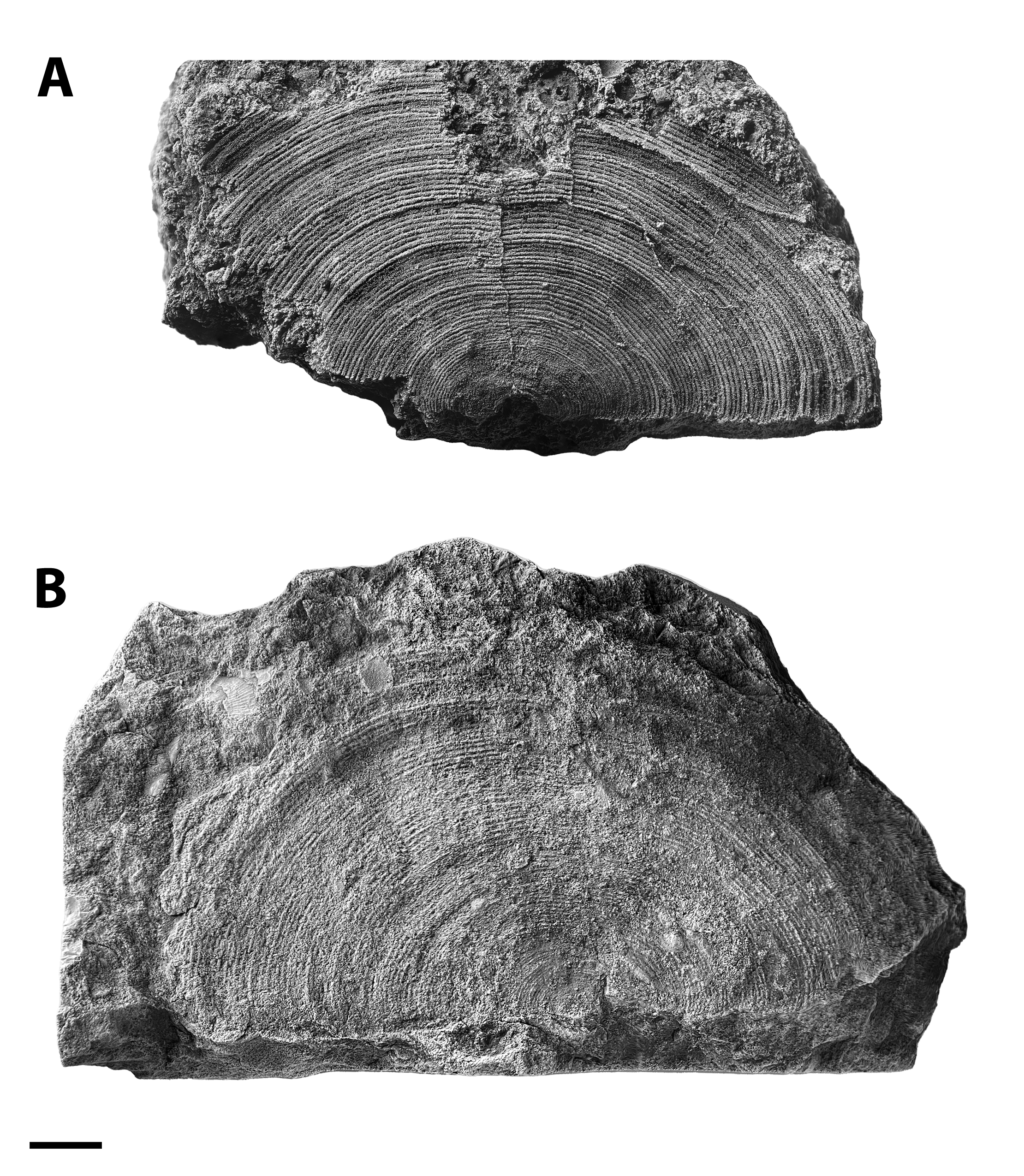Class Rhynchonellata Williams 1996
Order Dictyonellida Cooper 1956
Family Isogrammidae Schuchert 1929
Genus Isogramma Meek and Worthen 1870
The brachiopod Isogramma Meek and Worthen (1870) can be challenging to identify when found by inexperienced collectors. These fossils appear as a half circle covered with sharp concentric ridges, resembling the ridges on a vinyl record. The ventral valve has a narrow triangular depression running from the beak about halfway down the shell, where the growth lines disappear, while the dorsal valve does not.
Isogramma grows larger than any other brachiopod found at the same time, up to 18 cm wide. Specimens usually appear flattened and often fragmentary, making their identification as a brachiopod shell difficult. The shells were slightly concavo-convex in life, but due to a “spongy” shell, they are readily flattened after the end of life. Isogramma was probably also quite delicate in life: most adult specimens show areas of damage and regrowth, marked by sudden changes in the concentric surface ridges.
Stojanović-Kuzenko (2003) published unflattened figures of a new species, Isogramma serbica. The figures (Plate 1, figures 1-4) show the life morphology of Isogramma well. Chen and Shi (2016) called the genus “one of the most morphologically characteristic genera among Late Palaeozoic brachiopods.” The pair assembled an evolutionary history of the genus, claiming rapid diversification after its origination but suffering a setback during a Mid-Carboniferous extinction event.
Sturgeon and Hoare (1968) reported Isogramma millepunctata from the Lower Mercer limestone within the Pottsville Group, an older group, and the Cambridge limestone. Cambridge is the name in Ohio for the Nadine limestone in Pennsylvania.
The North American species of Isogramma reported for the upper Carboniferous are I. millepunctata, most common in the Moscovian, which was relatively small and flat for the genus (up to 6 cm wide) and had sharp ornament; I. texanum Cooper (1952) from the Gzhelian which was similar in size to I. millepunctata but more convex, with very fine concentric ridges; and I. renfrarum Cooper (1952) from the Moscovian through Gzhelian, the giant of the genus approaching nearly 20 cm wide, resembling a very large I. millepunctata from the outside, with some internal differences that can only rarely be seen. The specimens shown here are likely I. renfrarum based on size and age.

References
- Cooper, G.A., 1952. Unusual specimens of the brachiopod family Isogrammidae. Journal of Paleontology, 26: 67–83
- Stojanović-Kuzenko S., 2003, A new carboniferous species of isogramma (dyctionellida, brachiopoda) from NW Serbia, Geoloski anali Balkanskoga poluostrva, Issue 65, pp. 47–53
- Sturgeon, M.T., Hoare, R.D., 1968, Pennsylvanian Brachiopods of Ohio, State of Ohio Division of Geological Survey, Bulletin 63, 95 pages, 22 plates.
- Z.Q. Chen, G.R. Shi, 2006, Isogramma Meek and Worthen, 1870 (Dictyonellida, Brachiopoda) from the upper Palaeozoic of East Asia: Implications for biogeography and evolutionary trends, Journal of Asian Earth Sciences, Volume 26, Issues 3–4, pages 405–423

Late Carboniferous Fossils from the Glenshaw Formation in Armstrong County, Pennsylvania
Preface | The Photographic Process
Localities: Locality SL 6445 Brush Creek limestone | Locality SL 6533 Pine Creek limestone
Bivalvia: Allopinna | Parallelodon | Septimyalina
Cephalopoda: Metacoceras | Poterioceras | Pseudorthoceras | Solenochilus
Gastropoda: Amphiscapha | Bellerophon | Cymatospira | Euphemites | Glabrocingulum | Meekospira | Orthonychia | Patellilabia | Pharkidonotus | Retispira | Shansiella | Strobeus | Trepospira | Worthenia
Brachiopoda: Cancrinella | Composita | Isogramma | Linoproductus | Neospirifer | Parajuresania | Pulchratia
